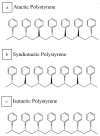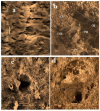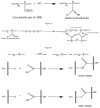Upcycling Polystyrene
- PMID: 36433142
- PMCID: PMC9695542
- DOI: 10.3390/polym14225010
Upcycling Polystyrene
Abstract
Several environmental and techno-economic assessments highlighted the advantage of placing polystyrene-based materials in a circular loop, from production to waste generation to product refabrication, either following the mechanical or thermochemical routes. This review provides an assortment of promising approaches to solving the dilemma of polystyrene waste. With a focus on upcycling technologies available in the last five years, the review first gives an overview of polystyrene, its chemistry, types, forms, and varied applications. This work presents all the stages that involve polystyrene's cycle of life and the properties that make this product, in mixtures with other polymers, command a demand on the market. The features and mechanical performance of the studied materials with their associated images give an idea of the influence of recycling on the structure. Notably, technological assessments of elucidated approaches are also provided. No single approach can be mentioned as effective per se; hybrid technologies appear to possess the highest potential. Finally, this review correlates the amenability of these polystyrene upcycling methodologies to frontier technologies relating to 3D printing, human space habitation, flow chemistry, vertical farming, and green hydrogen, which may be less intuitive to many.
Keywords: environmental assessment; plastic pollution; polystyrene; recycling; sustainability; waste plastics.
Conflict of interest statement
The authors declare that they have no conflict of interest.
Figures












































References
-
- Larrain M., Van Passel S., Thomassen G., Van Gorp B., Nhu T.T., Huysveld S., Van Geem K.M., De Meester S., Billen P. Techno-Economic Assessment of Mechanical Recycling of Challenging Post-Consumer Plastic Packaging Waste. Resour. Conserv. Recycl. 2021;170:105607. doi: 10.1016/j.resconrec.2021.105607. - DOI
-
- Peinado F., Aldas M., López-Martínez J., Samper M.D. Recycling of the Styrene Fraction from Post-Consumer Waste. Mater. Tehnol. 2020;54:725–730. doi: 10.17222/mit.2020.043. - DOI
-
- Hirayama D., Nunnenkamp L.A., Braga F.H.G., Saron C. Enhanced Mechanical Properties of Recycled Blends Acrylonitrile–Butadiene–Styrene/High–Impact Polystyrene from Waste Electrical and Electronic Equipment Using Compatibilizers and Virgin Polymers. J. Appl. Polym. Sci. 2022;139:51873. doi: 10.1002/app.51873. - DOI
-
- Civancik-Uslu D., Nhu T.T., Van Gorp B., Kresovic U., Larrain M., Billen P., Ragaert K., De Meester S., Dewulf J., Huysveld S. Moving from Linear to Circular Household Plastic Packaging in Belgium: Prospective Life Cycle Assessment of Mechanical and Thermochemical Recycling. Resour. Conserv. Recycl. 2021;171:105633. doi: 10.1016/j.resconrec.2021.105633. - DOI
-
- Zhao X., Korey M., Li K., Copenhaver K., Tekinalp H., Celik S., Kalaitzidou K., Ruan R., Ragauskas A.J., Ozcan S. Plastic Waste Upcycling toward a Circular Economy. Chem. Eng. J. 2022;428:131928. doi: 10.1016/j.cej.2021.131928. - DOI
Publication types
Grants and funding
LinkOut - more resources
Full Text Sources
Molecular Biology Databases

